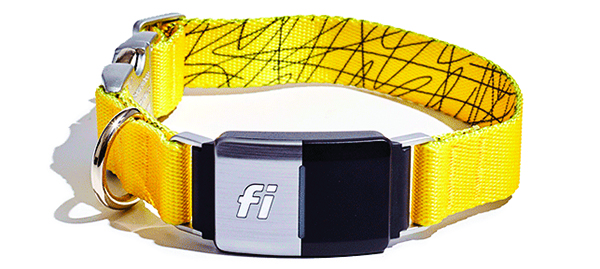Fi Smart Dog Collar Review
As our review of the Whistle Go Explore and Fitbark GPS activity/tracking collars (“Helping You Keep Track,” WDJ December 2020) went to press, we spotted an online ad for the Fi Smart Dog Collar (pronounced “Fie” as in “WiFi”) and decided to review it, too.
We bought and began testing Fi’s Series 1 collar in November 2020 – just before Fi released a Series 2 collar. Argh! Fi says the Series 2 offers a longer battery life, reinforced hardware (to address reports by Series 1 users of D-ring failures), and an upgraded antenna for improved tracking in remote locations.
Having purchased the Series 1 collar, and with our review of its major competitors already in print, we asked Fi if they’d send us a Series 2 for review. They agreed, but reported that strong orders for the product led to a fulfillment delay. Thus, we weren’t able to get our hands on a Series 2 in time for this review. What follows is our review of a Series 1 collar, along with reports of Series 2 improvements from consumers in a Fi user’s group on Facebook, as well as from Fi.
THE FI SMART COLLAR GPS ACTIVITY TRACKER AT A GLANCE
| Product Name Maker’s Website WDJ Rating |
Price Monthly Fee Guarantee |
Charging | Comments, Pros, Cons |
|---|---|---|---|
| Fi smart collar
tryfi.com Rating: 3 Paws (out of 4) ”A good product with one or two significant flaws.” |
$149 from Fi Not available from Amazon Subscription costs: $99/year 30-day free trial for tracking; afterward, a subscription is needed. |
Charges via a small base unit.
Charge for “homebody dogs” said to last as long as 3 months. In our test, it took 7 weeks of twice-daily dog walks plus occasional other adventures to draw just 60% of the battery’s charge. |
Things we like: The battery life is impressive. The 30-day free trial and ability to use the collar to track physical activity even without a GPS subscription are nice features. We enjoyed the ability to see the specific route traveled during a walk (similar to human fitness apps). The social media community and ranking features of the app are a nice touch.
Things we dislike: Reporting occasional car rides as walks is a frustrating issue we hope Fi finds a way to fix. The size of the device means it’s likely too big for many toy breeds. The device can only be used with Fi-compatible collars. |
HOW FI WORKS
Most of the time, the Fi gathers location information via Bluetooth from the included base unit or from a connected mobile device, rather than constantly searching for GPS points, which rapidly consumes the battery charge. When the “lost-dog” mode is engaged, Fi uses three constellations of satellites combined with AT&T’s LTE-M network coverage to triangulate position and send data to the user via a mobile-device app.

DESIGN AND PRICING
While the previously reviewed Whistle Go Explore and FitBark GPS trackers are designed to attach to a dog’s existing collar, the Fi Smart Collar is built into a custom collar. The tracking device itself can be removed from this collar, but it can be used only on Fi-compatible collars. Overall, the Fi is sleeker than the boxy Whistle and FitBark trackers.
The tracking device is about the size of a Matchbox toy car and is made of brushed steel and black plastic. A thin stripe in the middle functions as a light bar that’s controlled by the app. The Fi Smart Collar comes in four sizes (S, M, L, and XL); the smallest Fi fits a neck circumference as small as 111/2 inches (and is not recommended for tiny breeds).
The Fi Smart Collar sells for $149. GPS tracking is free for the first 30 days; after that, GPS service plans start at $99 for one year with minor discounts on multi-year plans. Unlike the other devices we tested, Fi will record and report the dog’s physical activity (not location) without a paid service plan.
SET UP
To use the collar, download the Fi app, create a profile for your dog, and designate his or her “safe zones.” Unique to Fi is the use of a small base unit that doubles as a charger and connects to the tracker using Bluetooth Low Energy (BLE) technology. The advantage, says a Fi representative, is that when the tracker is connected to a base unit or associated mobile device, it doesn’t need to access GPS location data via the tracker, which improves overall battery performance. A reported improvement to the Series 2 collar is WiFi integration, said to offer longer battery life when away from the base or mobile device, better signal coverage, and faster, more reliable escape detection.
We like how the tracking unit magnetically attaches to the base/charger, and the tracker charges quickly. Be sure to have a back-up collar with ID tags on hand when charging the Fi Smart Collar since the all-in-one device must be removed, leaving the dog without a collar.
BATTERY LIFE
Fi estimates a fully charged battery will last up to three months for dogs who are always home, up to two months on dogs who leave the house for daily neighborhood walks, and up to three weeks on especially active dogs who spend a lot of time away from home in situations where the collar might not maintain a reliable Bluetooth connection to the base unit or owner’s mobile device.
Our tests confirm that these estimates are not overstated. When test-dog Saber stayed home during the workweek but joined me on twice-daily walks and occasional weekend hiking excursions, the Fi still had more than 40 percent of its battery charge after seven weeks. Impressive! And the WiFi integration on the Series 2 collar is said to produce even better overall battery life.
Fi claims the battery will last for up to two days in “lost dog mode,” where it’s relying on GPS to refresh the dog’s location every minute. This is important, as any tracker is useless with a dead battery. However, “up to two days” means when starting with a fully charged battery. When using any tracking device on a canine escape artist, closely monitor the battery to keep it fully charged.
WATER RESISTANCE AND DURABILITY
The Fi Smart Collar is waterproof and saltwater spray resistant. It’s also designed with an armored aluminum face plate and reinforced internal metal armor to help protect against gnashing teeth during bitey-face play.
APPLICATION REPORTING
The Fi app uses an algorithm to measure steps taken as well as miles traveled. In our test, Saber’s reported step count was consistently close to double that of my steps, as reported by my FitBit.
Activity is reported in three categories: Time spent and steps taken in a designated safe zone; time spent, steps taken, and distance traveled on a walk; and time spent and steps taken during play. Activities are reported chronologically throughout the day, with a map showing the activity’s location – including the full route taken on a walk, similar to exercise apps such as RunKeeper or MapMyRun.
The Fi app also offers fun community features such as photo sharing with other Fi users, as well as activity rankings including overall, by breed, and within your state and city. I’ll admit that when I set out to walk twice a day, it was fun to watch Saber’s rank climb to the top 15% of all Fi-wearing dogs.
ACCURACY/RELIABILITY
We simulated a lost dog scenario by asking a neighbor to take Saber on a walk. I watched Saber leave and waited for notification that he’d left the safe zone – which took a full three minutes. Fi claims on its website that it provides “the fastest, most accurate way to be notified when your dog escapes.” We found it to be faster than the FitBark, but not nearly as fast as the Whistle Go Explore, which prompted an alert on the phone app within one minute of Saber’s “escape.”
Escape detection is said to be another area of improvement with the Series 2 Fi Smart Collar. Note that location tracking may be slower in landscapes that are densely built up, as well as remote areas with limited cellular coverage.
Once I received an alert that Saber had left a “safe zone” I activated the Fi’s “lost dog” mode, triggering GPS-based location updates every 60 seconds. Its location information was extremely accurate. I easily found Saber strolling with my neighbor about two blocks away from home.
One frustrating issue is the frequency with which Fi registers car rides as walks. Saber might be fast, but he definitely never walks at 65 miles per hour! Fi’s tech support advised keeping the app open in the background throughout the day to reduce these inaccurate reports. It definitely helped, but it also appeared to draw a significant amount of my phone’s battery. Fi is aware of this issue and says it’s working to resolve this with future app updates.
FINAL APPRAISAL
No technology is perfect, which is why no GPS tracker should be a substitute for good fences and training a solid recall. Whereas the Whistle and FitBark products we reviewed combine GPS tracking capabilities with a variety of health and activity insights, Fi says its tracker is designed first and foremost to be a lost-dog device that gives owners the best chance of being reunited with their dogs. Based on battery life alone, this claim feels solid – since no GPS tracker can overcome a prematurely dead battery.





